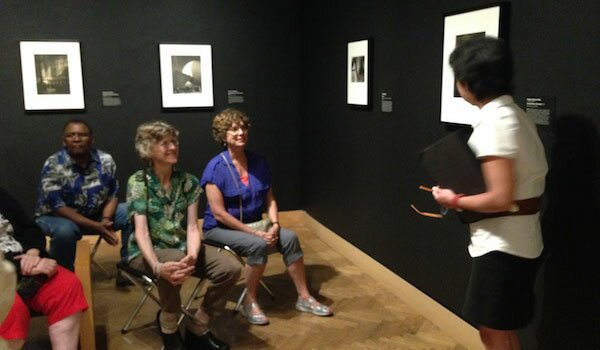WARM August Program Review

WARM Conversation: MIA Women’s Art Tour.
STRONG, BOLD, AND BEAUTIFUL
Having a conversation about works of art can be intriguing, but contributing to a spirited discussion about the personal virtues and powerful women, who were the trail blazers, artists, muses, and patrons, is even more compelling and worth sharing. At the August WARM program, the MIA docent led tour with Joy Yoshikawa did just that, and it also provided a glimpse into a handful of women artists and contributors in the museum’s vast collection.
The tour began with our eyes gazed upon a late 18th century painting by Vigee Le Brun, French court painter to Marie Antoinette. Joy leads our conversation through the formal elements of the Portrait of Countess Bucquoi - composition, color, and technical skills of the artist, and then addresses the historical significance and strength of Le Brun and Marie Antoinette as women artist and patron during the societal and political upheaval of the French Revolution. Another element that sets Le Brun apart and leaves an impact is that this piece is the oldest, signed work by a women artist in the collection.
What happened next engaged our audience to further participate in a feminist dialogue. While combing every inch of the deeply-carved, beautiful marble surface of Harriet Hosmer’s sculpture, we launched into the life and times of this woman artist from the 1850’s. Hosmer’s skills and courageous encounter with the bust of Medusa depicts not a frenzied rapture, but a stunning state indicative of her quote, “I honor every woman who has strength enough to step out of her beaten path to pave a broader way for another.” While Hosmer was criticized for her use of historic plights of women and ridiculed for successful business practices, such as the use of assistants, her bust ofMedusa prevails not as a victim or gorgon, but as a powerful women.
The celebration of art and women as muse, pioneer and collector revealed itself as we paused to peer at the bronze Eve With Apple by Aristide Maillol and photographTerminal Tower, Cleveland by Margaret Bourke-White. Amongst the polished sculpture we learn about Dina Vierny. Not only was she the inspiration and model behind Maillol’s works, as well as Mattise, she also became an art collector. Purely a model, and later a friend to both Mattise and Maillol, she went on to open the Musee Maillol in Paris. Lora Weinstein, also a collector along with her husband Martin, contributed an extensive photography collection to the MIA. It is through White’s gritty, black and white image that the conversation turns to expression, feelings and a sense of atmosphere. With this murky photo before us we become aware of the realities that machines brought to industry, harkening back to the 1930’s – the Depression and to World War II through White’s lens. Her ability to express truth through simplicity captured human drama and White’s tenacity for opportunity bestowed her both the triumph of first women war correspondent and first women photographer to be on the cover of Life magazine.
Joy covered a lot of ground and continued to capture our attentions by touching on the importance of women and art through the use of materials and culture. What do you say or sense standing in front of nine foot cube perfectly constructed of smaller cubes of barbed wire? As individuals walked around the massive piece by Mona Hatoum responses came from the gut, as well as the heart. Reactions included the use of linear perspective and minimalism, to precision and change in lines, to notions of danger and reflections of discomfort. From this rigid and evocative work the group next experienced an extreme material contrast in design and intent while looking at the softness and elegance of Anishinabe (Ojibwe) Bandolier Bags. With the makers unknown and the traditional purpose clear, that the women makers of these objects devoted themselves to the respect and beauty of their culture, rows of intricate, exquisite beadwork and symbolic bold, motifs speak to the values and masterworks of the nameless women contributing to cultural heritage and respect for their people.
Some quick walk-by’s provided a peak into Margarete Schutte-Lihotzky’s post-war industrial kitchen design and a digital projection by Jennifer Steinkamp whose 6EQUJ5animated work transforms the museum’s rotunda ceiling. Moving through gallery’s our tour timeline journey started in 1793 and cycled to the women artists of today. The last object, which generated close inspection and awestruck wonderment, was the mystifying porcelain work of Japanese artist Tokumaro Kyoto. The beauty in the patterns and rhythms of this botanical piece seemed to feel lighter than air with a surface and cluster of plant-like shapes reeling us all in to examine the artists sensitivity and courageous execution of her creative process. Cosmic Plants was the perfect piece to close our evening at the MIA because this work captured the powerful nature and stories of the contributors, artists and strength of all the women we were introduced to in the MIA’s vast collection.
I’m left with wanting more! Let’s do this again Program Committee.
- Linda Seebauer Hansen
Leave a Reply